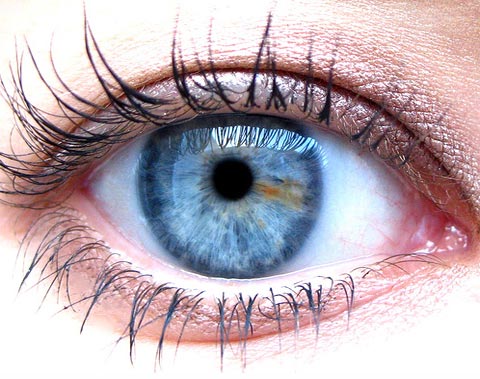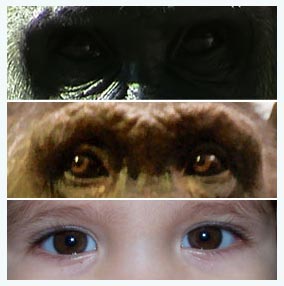Human eyes have strange attraction
With humans, the eyes are not only windows that open to the outside world, but they are also directed inside, revealing the world of souls with feelings and private thoughts.
Of all primates, the human eye is most noticeable. Eyes are for seeing, but for others to see. Our blacks float on a white background and surround the pupils. This color contrast is not available in most other monkey species.
According to one hypothesis, this feature is to help us keep track of other people's eyes better when talking or when we act together.

(Photo: flickr.com)
In a new study that first tested this hypothesis, researchers at Max Planck Institute for Evolutionary Anthropology in Germany investigated the effect of eye movement, head on the orientation of the ape's eyes. and babies.
In the study, one person will perform the following movements: Close your eyes, head to the ceiling; keep your head straight and look up at the ceiling; raise your head and look at the ceiling; Keep your head straight and look forward.
The results showed that human apes - including 11 chimpanzees, 4 gorillas and 4 bonobo monkeys - all followed the eyes of the experimenter when he only moved his head. In contrast, 40 newborn babies look more closely when the testers move their eyes.
The gibbons are more affected by the head than the eyes when they want to follow the eyes of the opposite person, while humans rely more on the eyes in the same situation.

Gorilla eyes, chimpanzees and children's eyes.
(Photo: Livescience)
The comparison of human eyes with other primates also reveals small differences that make our eyes stand out. For example, the human eye lacks certain pigments such as those in primates, so the outer epidermis of the eye is white. In contrast, most primates have a black or brown outer membrane, making it difficult to determine the direction of sight.
Another potential help that helps us determine where a person is looking is the contrast between the face, the outer membrane and the iris. Most apes have low contrast between their eyes and face.
Humans are the only primates with the contours of the eyes and the position of the iris. In addition, our eyes are also slender horizontally and have quite a large proportion of the entire body. Meanwhile, chimpanzees have massive bodies but their eyes are quite small.
These characteristics make communication and collaboration easier. For example, the mother and the baby are mostly in eye contact when interacting. One study found that babies looked twice at their caregivers' faces and eyes twice as much as gibbons.
The white outer membrane is also a sign of good health and a potential sign to find a partner.
MT
- The mystery of eyes 'killing people with just one look'
- Strange possibilities of eyes
- People use fluent eyes language from birth
- 19 most obsessive eyes in the history of world photography
- Strange story: The stone has eyes, crying like a human
- How far are our eyes?
- The syndrome looks strange dragon dragon
- Successful testing of chemicals helps human eyes to look like cat's eyes
- Why stay up late or get dark?
- Girls have 'X-ray eyes'
- How far can human eyes be?
- Surprise with the most appreciated point on the face
 'Fine laughs' - Scary and painful torture in ancient times
'Fine laughs' - Scary and painful torture in ancient times The sequence of numbers 142857 of the Egyptian pyramids is known as the strangest number in the world - Why?
The sequence of numbers 142857 of the Egyptian pyramids is known as the strangest number in the world - Why? History of the iron
History of the iron What is alum?
What is alum?